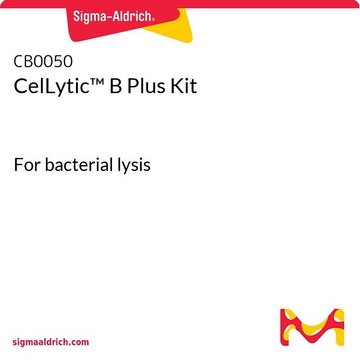Key Documents
P8849
Protease Inhibitor Cocktail
DMSO solution, for the inhibition of serine, cysteine, aspartic, aminopeptidases and thermolysin-like activities, for use in purification of Histidine-tagged proteins, DMSO solution
Synonim(y):
Protease inhibitor solution
About This Item
Polecane produkty
product name
Protease Inhibitor Cocktail, for use in purification of Histidine-tagged proteins, DMSO solution
pochodzenie biologiczne
synthetic
Poziom jakości
Postać
DMSO solution
temp. przechowywania
−20°C
Szukasz podobnych produktów? Odwiedź Przewodnik dotyczący porównywania produktów
Opis ogólny
The cocktail contains a mixture of inhibitors that specifically target serine, cysteine, aspartic, and thermolysin-like proteases, and aminopeptidases.
Specyficzność
Zastosowanie
It is recommended for inhibition of protease activity in 100 mL of cell lysate from 20 g of Escherichia coli or 10 g of baculovirus-infected Spodoptera frugiperda pupal ovary cells.
Cechy i korzyści
Targets multiple types of proteases, ensuring comprehensive inhibition of protease activity.
Compatibility with IMAC applications due to omission of chelating agents.
Supplied in convenient packaging options.
Komponenty
Bestatin
E-64
Pepstatin A
Phosphoramidon
Ilość
This protease inhibitor cocktail has been optimized and tested for histidine-tagged proteins
Uwaga dotycząca przygotowania
produkt powiązany
Kod klasy składowania
10 - Combustible liquids
Klasa zagrożenia wodnego (WGK)
WGK 1
Temperatura zapłonu (°F)
185.0 °F - closed cup
Temperatura zapłonu (°C)
85 °C - closed cup
Certyfikaty analizy (CoA)
Poszukaj Certyfikaty analizy (CoA), wpisując numer partii/serii produktów. Numery serii i partii można znaleźć na etykiecie produktu po słowach „seria” lub „partia”.
Masz już ten produkt?
Dokumenty związane z niedawno zakupionymi produktami zostały zamieszczone w Bibliotece dokumentów.
Klienci oglądali również te produkty
Powiązane treści
Wybierz różne typy inhibitorów proteaz w zależności od potrzeb, aby zapobiec degradacji białek podczas izolacji i charakteryzacji oraz zabezpieczyć białka podczas przygotowywania próbek.
Nasz zespół naukowców ma doświadczenie we wszystkich obszarach badań, w tym w naukach przyrodniczych, materiałoznawstwie, syntezie chemicznej, chromatografii, analityce i wielu innych dziedzinach.
Skontaktuj się z zespołem ds. pomocy technicznej















